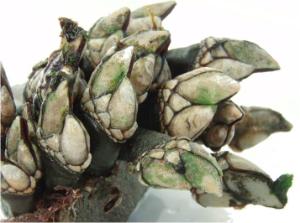News & Opportunities
New paper: Reproductive conditioning of stalked barnacles

Abstract: Pollicipes pollicipes (Crustacea; Pedunculata) is a delicacy on the Iberian Peninsula where, in recent years, stock shortages associated with high market value have increased interest in the aquaculture potential of this species. Though broodstock has been maintained in captivity, detailed culture conditions are lacking. The present study investigated the effects of rearing temperature on reproductive conditioning. During a 4-week period, broodstock were subjected to temperature regimes characteristic of stable spring temperatures (spT), increasing spring to summer temperatures (sp–suT) and increasing spring to summer temperatures with daily fluctuations of 1 °C (sp–suT2). Broodstock were monitored for fecundity, egg lamella development and maturation, larval release rate, nauplius size and survival over 24 h. Cultured broodstock were fecund at smaller sizes (15.94 ± 0.23 mm RC) than wild-collected individuals at the beginning of the experiment (17.71 ± 0.65 mm RC). Fecundity increased significantly in all treatments and development of egg lamellae was highest in treatments in which the temperature increased over the experimental period (average 36% of mature egg lamellae in comparison to an initial 0%). Increasing temperature led to greater maturation of lamellae and more frequent spawning peaks. The number of nauplii released per aquarium (average 110 adult individuals) varied according to treatment and time, averaging 4670 ± 506 nauplii day− 1. Due to the low number of larvae released daily, it is suggested that adults might release larvae gradually, as embryos hatch within the mantle cavity. Average release rates increased towards the end of the conditioning period, with releases on peak days ranging from 10,000 to 30,000 nauplii per aquarium. For spT, peak values were observed in week 3, while sp–suT and sp–suT2 showed peaks of release in weeks 2 and 4, when temperatures averaged 20 and 23 °C, respectively. Temperature oscillations led to shorter intervals between peaks of release. In terms of the larvae released, there were neither differences in numbers between treatments (128,147 ± 13,548 nauplii per aquarium over 28 days) nor in size of nauplii (202.89 ± 0.69 μm GW) or 24-h survival (91.56 ± 0.35%). Notwithstanding the need for further optimization, broodstock reproductive conditioning can be accomplished and a continuous supply of larvae obtained using the protocols described herein. Future studies should focus on the impact of food quality and photoperiod on reproductive conditioning, as well as the optimization of larval release induction protocols.
Last modified: Mon, 19 Oct 2015 15:23:00 BST